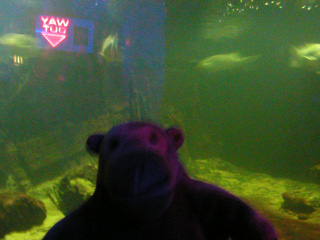

#REAL SEAMONKEY CODE#
Mozilla Gecko engine, the same code which Internet browser, email & newsgroup client, HTML editor, IRC chat and webĭevelopment tools, SeaMonkey is sure to appeal to advanced users, web
#REAL SEAMONKEY SOFTWARE#
Such a software suite was previously made popular by Netscape and Mozilla,Īnd the SeaMonkey project continues to develop and deliver high-quality updatesĪs well as new features and improvements to this concept. Over the next few days and weeks, add your other pouches to the water - this is the Monkeys’ diet: yeast and spirulina.The SeaMonkey project is a community effort to develop the SeaMonkey

Pouring this pouch into the water will start their new life. One pouch, which seemingly looks like a powder, is actually the lifeless colony of Sea-Monkeys. So, what exactly is the elixir of life that allows for Sea-Monkeys to really grow? When you snatch a packet of Sea-Monkeys off the shelf, you’ll discover a few different pouches inside. There’s no real scientific evidence behind this new hybrid living much longer or growing much larger than the original species of brine shrimp that von Braunhut started with. Forget a few days - now your Sea-Monkeys were set for “life!” Well, let’s use the term “life” rather loosely. The two created a new, more durable breed of shrimp they called Artemia NYOS. Von Braunhut set out to create a new hybrid of the brine shrimp known as “Super Sea-Monkeys!” He recruited the help of microcrustacean expert and marine biologist, Anthony D’Agostino, to take his current revival process to the next level. But don’t worry, he had a solution for that too! Super Sea-Monkeys Not only could you grow your own Sea-Monkeys in their very own Sea-Circus Aquarium, but you could also opt for growing your own Living Monsters!īut the not-so-magical part of von Braunhut’s living toy that kids were quickly discovering is just how short of a lifespan their new Sea-Monkey family actually had. He also depicted them performing all kinds of unique talents and skills like playing baseball and getting hypnotized! Robert Ripley’s Living MonstersĪctually, von Braunhut wasn’t the only one embellishing the feats of these little swimmers! Believe It or Not!, Robert Ripley joined in on this whole fad, and added a Ripley’s spin of course. His team of talented illustrators depicted the Sea-Monkeys as magical beings - little monkeys with fish-like bodies and crown-like heads. To further advertise the potential of this glorified pet food, von Braunhut hired “Sea-Monkey artists” to help him illustrate the many possible roles of these little guys to their owners. And to make money-making even easier, all kids had to do was send the cash to the address in the ad and their Sea-Monkeys would show up at their doorstep. Rather than opt for the expensive and flashy television commercials others had been using, von Braunhut went straight to the eyes of his juvenile target market. When he was essentially denied from all the big-box toy brands at the time, he took matters into his own hands. He worked out of his self-made factory (aka his barn) to assemble orders and try to find retailers willing to pick up his idea to sell.
#REAL SEAMONKEY FULL#
Marketing this life in a bag as a “bowl full of happiness,” von Braunhut found great success in his brine goldmine. All you had to do was provide a tank or living space and fill it with water. This process would allow for people to take home the shrimp and, essentially, “grow them” on their own! A Bowl Full of Happinessĭuring the product’s 1960s debut, von Braunhut was selling these kits for only 49 cents a pop! Under the name “Instant Life,” each set of supplies included a packet of shrimp and a packet of nutrients for them to eat. When water is added to this shell, the shrimp could be revived.Įager to make a little bang for his buck, von Braunhut experimented with these creatures and figured out a way to mix nutrients with average tap water, thus creating an elixir of life for these dried brine shrimp. With the evaporation of the water in these areas, the tiny shrimp are left with nothing but a high-sodium diet to survive, causing them to move into a state of “suspended animation.” In a process known as cryptobiosis, the shrimp are encased in a cyst-like protective coating (basically, a dehydrated shell). Known as Artemia salina, this particular species thrives in salt lakes or salt flats. Sea-Monkeys and Suspended Animationīack in 1957, a man named Harold von Braunhut became fascinated with a species of brine shrimp that were commonly sold as a source of pet food. There was once a time when no child could flip through Highlights 0r other magazines without seeing a piece of cut-out collateral featuring the toy-pet hybrid known as Sea-Monkeys! Let’s dive a little deeper into the magic of suspended animation and the species of brine shrimp known as Artemia salina.


 0 kommentar(er)
0 kommentar(er)
